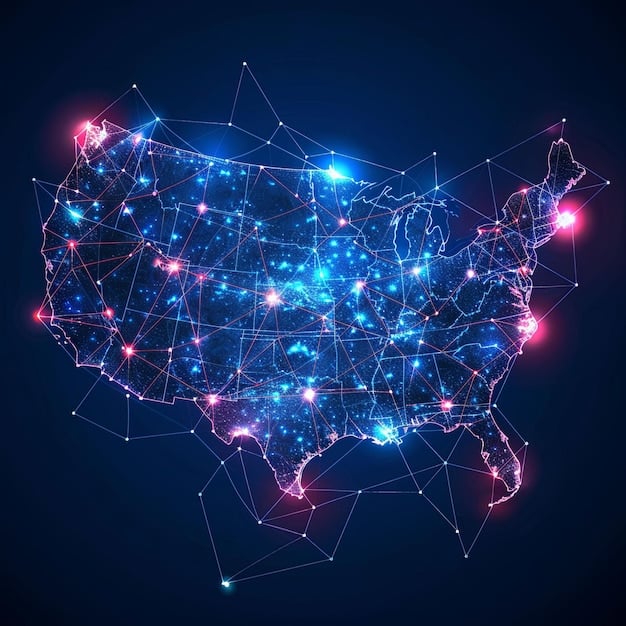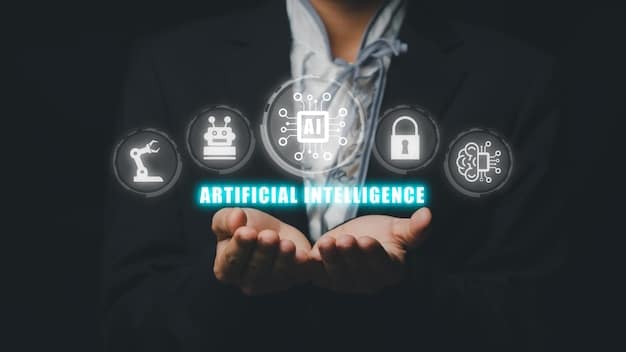US Tech: AI Ethics Guidelines 2025 Impact Revealed

The updated AI ethics guidelines in 2025 are poised to significantly reshape operations for US tech companies, demanding a proactive embrace of responsible AI development, enhanced transparency, and robust accountability frameworks to navigate evolving regulatory landscapes and maintain public trust.
As artificial intelligence continues its rapid ascent, its ethical implications demand increasing scrutiny. For US tech companies, 2025 is shaping up to be a pivotal year, with updated AI ethics guidelines poised to significantly impact their operations. These evolving frameworks will necessitate a fundamental shift in how AI is developed, deployed, and governed, moving from theoretical discussions to concrete, enforceable standards.
The Evolving Landscape of AI Regulation in the US
The discourse surrounding AI ethics has matured rapidly, shifting from abstract philosophical debates to tangible policy proposals. In the United States, this evolution is particularly dynamic, driven by a confluence of technological advancements, increasing public awareness, and a growing consensus among policymakers that a fragmented approach to AI governance is unsustainable. The year 2025 represents a critical juncture, where various federal initiatives, state-level legislation, and industry self-regulation converge to form a more cohesive, albeit complex, ethical framework.
Federal Initiatives and Executive Orders
The US government has been progressively laying the groundwork for AI ethical guidelines. Executive Orders, policy whitepapers, and congressional hearings have underscored an intent to foster responsible AI development while preserving American innovation. These initiatives often emphasize core principles such as safety, security, privacy, and the mitigation of bias. The push is not merely reactive; it aims to position the US as a leader in ethical AI, influencing global standards.
- NIST AI Risk Management Framework: This voluntary framework offers guidance for managing risks associated with AI, providing a practical toolkit for organizations to incorporate ethical considerations into their AI lifecycle. Its principles are increasingly influential in both public and private sectors.
- White House Blueprint for an AI Bill of Rights: While non-binding, this blueprint outlines five key protections that Americans should have in the age of AI. It serves as a strong signal of administrative priorities, focusing on safe and effective systems, algorithmic discrimination protections, data privacy, notice and explanation, and human alternatives, and fallback.
- Congressional Interest: Various legislative proposals have emerged from both sides of the aisle, indicating a bipartisan recognition of the need for AI regulation. These proposals range from mandates for impact assessments to stricter rules around high-risk AI applications.
State-Level Regulations and Industry Actions
Beyond federal efforts, several US states have begun to enact their own AI-related legislation, creating a patchwork of rules that tech companies must navigate. States like California, New York, and Illinois have often been at the forefront of privacy and data protection, and they are extending this proactive stance to AI. This decentralized approach means companies often face differing compliance requirements depending on where their products or services operate. Simultaneously, leading tech companies are not merely awaiting regulation; many are developing internal ethical AI principles, review boards, and compliance teams. They recognize that a proactive stance on ethics can enhance public trust, strengthen brand reputation, and potentially preempt more stringent government mandates. This internal push often aligns with, and sometimes even anticipates, broader regulatory trends. Large tech firms, in particular, are investing heavily in AI governance structures to ensure their systems are developed and deployed responsibly.
The evolving regulatory landscape in the US for AI is characterized by a multi-pronged approach, incorporating federal guidance, state-specific laws, and industry-led initiatives. For US tech companies, understanding and anticipating these changes is paramount to maintaining compliance and fostering sustainable innovation. The shift towards concrete ethical guidelines is undeniable, demanding a strategic and adaptive response.
Transparency and Explainability: A New Mandate for AI Systems
The concept of the “black box” in AI, where complex algorithms make decisions without readily apparent reasoning, is rapidly becoming untenable. Updated AI ethics guidelines are placing significant emphasis on transparency and explainability, demanding that tech companies unravel the opacity of their AI systems. This isn’t just a technical challenge; it’s a fundamental shift in how AI systems are designed, developed, and communicated to users and regulators.
Demystifying Algorithmic Decisions
For a long time, the internal workings of advanced AI models, particularly deep learning networks, were largely inscrutable. This lack of visibility raised concerns about bias, fairness, and accountability, especially when AI systems were applied to critical domains like employment, credit, or criminal justice. New guidelines aim to bridge this gap, requiring companies to provide clear, understandable explanations for how their AI systems arrive at specific decisions or predictions. This might involve developing new methodologies for interpreting model outputs, or designing AI systems that are inherently more explainable from the outset.
The push for explainability means a move away from simply optimizing for performance metrics like accuracy. Developers will also need to consider how to make the decision-making process comprehensible to a human. This can involve techniques such as LIME (Local Interpretable Model-agnostic Explanations) or SHAP (SHapley Additive exPlanations), which help to identify the features most influential in a model’s prediction. The goal is to ensure that a user or regulator can understand not just what an AI system does, but why it does it.
User Trust and Regulatory Compliance
Enhanced transparency contributes directly to building greater user trust, which is crucial for the broader adoption and acceptance of AI technologies. When individuals understand how an AI system impacts them, they are more likely to trust its outputs and feel confident in its use. From a regulatory perspective, transparency is key to compliance. Regulators need to be able to audit AI systems, identify potential biases, and ensure adherence to ethical standards. Without clear documentation and explainable models, effective oversight becomes impossible.
- Documentation Requirements: Companies will likely face increased demands for comprehensive documentation of their AI models, including training data, development methodologies, performance metrics, and ethical impact assessments.
- Interpretability Tools: The development and adoption of tools that can interpret and visualize AI model behavior will become essential. This includes not only technical tools for data scientists but also user-friendly interfaces for broader stakeholders.
- Clear Communication: Tech companies will need to improve how they communicate the capabilities and limitations of AI systems to end-users, ensuring that disclaimers are clear and not buried in fine print.
The implications of these transparency and explainability mandates are profound. They will compel US tech companies to integrate ethical considerations throughout the entire AI lifecycle, from initial design to deployment and ongoing monitoring. This will undoubtedly require investment in new tools, processes, and expertise, but the long-term benefits of increased trust and regulatory alignment are substantial. The days of obscure AI decision-making are numbered, paving the way for a new era of accountable intelligence.

Bias Mitigation and Algorithmic Fairness: A Critical Imperative
Addressing bias and ensuring algorithmic fairness are cornerstones of the updated AI ethics guidelines for US tech companies in 2025. The pervasive problem of bias, often reflecting societal prejudices embedded in training data or developer assumptions, can lead to discriminatory outcomes that erode trust and exacerbate inequalities. These new guidelines will mandate a proactive approach to identifying, mitigating, and monitoring bias across all stages of AI development and deployment.
Identifying and Quantifying Bias in AI Systems
The first step toward fairness is recognizing the presence of bias. This involves meticulous analysis of training data to detect underrepresentation, overrepresentation, or skewed distributions that could lead to unfair outcomes. Tech companies will need to adopt sophisticated tools and methodologies to quantify different types of bias, such as demographic bias, systemic bias, or statistical bias, and understand their potential impact on various user groups. This process extends beyond data to the algorithms themselves, requiring examination of how models learn and generalize from their inputs.
Quantifying bias isn’t a one-time task; it’s an ongoing commitment. As AI systems evolve and interact with real-world data, new biases can emerge. Therefore, continuous monitoring and re-evaluation will become standard practice. This vigilance ensures that even after initial development, the AI remains fair and equitable in its operational context. Without robust mechanisms for identification, mitigation efforts risk being superficial and ineffective.
Strategies for Fair AI Development
Once identified, bias must be systematically mitigated. The updated guidelines will likely recommend, and in some cases require, tech companies to implement a range of strategies to achieve algorithmic fairness. These strategies can be applied at different points in the AI lifecycle:
- Data Pre-processing: Techniques to balance or augment datasets, remove sensitive attributes, or re-weight samples to reduce the impact of historical biases on model training.
- Algorithmic Interventions: Developing or selecting algorithms that inherently promote fairness, or incorporating fairness constraints directly into the model optimization process. This includes techniques that ensure similar performance across different demographic groups.
- Post-processing Techniques: Adjusting model outputs or predictions to meet specific fairness criteria, ensuring that outcomes do not disproportionately affect certain groups, while still striving for optimal performance.
Beyond technical fixes, organizational strategies are equally crucial. This includes fostering diverse AI development teams, implementing ethical review boards, and establishing clear accountability structures for fairness outcomes. The shift is towards embedding fairness as a core design principle rather than an afterthought. The impact for US tech companies will be significant. It will necessitate investments in specialized expertise, new tooling, and a cultural shift towards prioritizing ethical considerations alongside performance metrics. Companies that embrace these changes proactively will not only comply with future regulations but also build more robust, trustworthy, and socially responsible AI products that resonate with a diverse user base. Algorithmic fairness is no longer optional; it’s a fundamental requirement for ethical AI.
Data Privacy and Security Enhancements in AI Lifecycle
The symbiotic relationship between data and AI means that ethical guidelines concerning AI are inextricably linked to data privacy and security. As AI systems consume vast quantities of data, the updated guidelines in 2025 will impose stricter requirements on US tech companies, demanding a heightened commitment to protecting user information throughout the entire AI lifecycle. This will build upon existing data protection laws, extending their principles specifically to the unique challenges posed by AI.
Strengthening Data Governance for AI
Tech companies will need to fortify their data governance frameworks to ensure that data used for AI development and deployment is collected ethically, stored securely, and used appropriately. This involves comprehensive policies for data acquisition, anonymization, consent management, and data retention. The guidelines are expected to emphasize the principle of “privacy by design,” meaning that privacy considerations are integrated into AI systems from their inception, rather than being added as an afterthought. This includes techniques such as differential privacy, which adds noise to data to protect individual privacy while still allowing for aggregate analysis.
Moreover, the secure handling of synthetic data, often used to augment real datasets or to test AI models without exposing sensitive information, will also come under scrutiny. Companies will need to demonstrate that even synthetic data generation processes adhere to ethical standards and do not inadvertently re-identify individuals or perpetuate biases. The entire data pipeline, from raw intake to model training and deployment, must be transparently managed and auditable.
Impact of Privacy Regulations (e.g., CCPA, GDPR) on AI
Existing privacy regulations like the California Consumer Privacy Act (CCPA) and the European Union’s General Data Protection Regulation (GDPR) have already set a high bar for data protection. The updated AI ethics guidelines will likely reinforce and expand these principles, specifically tailoring them to AI contexts. For US tech companies serving a global user base, complying with both domestic and international privacy standards for AI will be complex but essential.
- Enhanced Consent Mechanisms: Companies will need more explicit and granular consent for data used to train AI models, particularly for sensitive personal information. Users should understand how their data contributes to AI development and have clear options to opt-out.
- Right to Explanation and Erasure: The “right to explanation” for algorithmic decisions, and the “right to be forgotten” (data erasure), will gain broader applicability to AI. This means companies must design AI systems that can explain their outputs and facilitate the removal of individual data points from training sets when requested.
- Robust Security Measures: The guidelines will likely mandate even stronger cybersecurity protocols to protect AI training data and deployed models from breaches, unauthorized access, and adversarial attacks that could compromise privacy or manipulate AI outcomes.
The convergence of AI ethics and data privacy promises a landscape where US tech companies must prioritize both innovation and robust data stewardship. Investing in advanced security technologies, adopting privacy-enhancing techniques, and establishing clear, transparent data practices will not only foster compliance but also build invaluable trust with users. The future of AI relies on its ability to respect and protect the data it consumes.
Accountability and Governance Frameworks for AI
As AI systems become more autonomous and influential, the question of accountability becomes paramount. The updated AI ethics guidelines for US tech companies in 2025 will move beyond aspirational principles, demanding concrete accountability and robust governance frameworks. This means establishing clear lines of responsibility, implementing rigorous auditing procedures, and ensuring mechanisms exist for recourse when AI systems cause harm. The era of “algorithm did it” as an excuse is rapidly drawing to a close.
Establishing Clear Lines of Responsibility
One of the key challenges in AI governance has been pinpointing who is ultimately responsible when an AI system malfunctions, makes a discriminatory decision, or causes unintended harm. The new guidelines will push for greater clarity, requiring tech companies to designate specific individuals or teams responsible for the ethical performance and compliance of their AI systems. This could involve roles such as an “AI Ethics Officer” or cross-functional teams dedicated to AI governance. These individuals or groups will be tasked with overseeing the ethical development, deployment, and ongoing monitoring of AI, ensuring that ethical considerations are integrated at every stage.
Clear accountability also extends to the processes themselves. Companies will need to document decision-making processes for AI development, from initial concept to model deployment, including the ethical assessments conducted at each phase. This trail of accountability provides a basis for review and ensures that ethical considerations are not merely checkboxes but integral parts of the development pipeline.
Auditability, Impact Assessments, and Recourse Mechanisms
For accountability to be meaningful, AI systems must be auditable. The updated guidelines will likely mandate regular, independent audits of AI systems to verify their compliance with ethical standards, fairness metrics, and data privacy regulations. These audits might inspect training data, model architecture, performance metrics across different demographic groups, and the effectiveness of bias mitigation strategies. Furthermore, the concept of AI “impact assessments” will become more prevalent, requiring companies to proactively evaluate the potential societal, ethical, and human rights impacts of their AI systems before deployment, similar to privacy impact assessments.
- Independent Auditing: Companies may need to engage third-party auditors to provide objective assessments of their AI systems’ ethical performance, adding an external layer of verification.
- Redress and Recourse: Crucially, the guidelines will emphasize the need for clear and accessible mechanisms for individuals to seek redress if they are negatively impacted by an AI system. This could involve an appeals process, human review of AI decisions, or compensation frameworks.
- Continuous Monitoring: Beyond initial audits, continuous monitoring of AI systems in real-world environments will be required to detect drift in performance, emergence of new biases, or unintended consequences that may arise over time.
For US tech companies, these accountability and governance frameworks will necessitate a significant investment in processes, personnel, and technological infrastructure. It will move AI ethics from a theoretical concern to a practical, operational imperative, challenging companies to embed ethical thinking deeply into their organizational culture. By embracing robust accountability, companies can not only mitigate risks but also build a stronger foundation of trust and legitimacy for their AI innovations.
Impact on AI Development Lifecycles and Business Models
The updated AI ethics guidelines are not merely a compliance burden; they represent a fundamental paradigm shift that will profoundly impact the AI development lifecycles and, consequently, the business models of US tech companies. In 2025 and beyond, companies will need to re-imagine everything from product conceptualization to market deployment, integrating ethical considerations as a core, rather than peripheral, aspect of innovation. This shift promises a more sustainable and trustworthy AI ecosystem.
Integrating Ethics from Design to Deployment
Traditionally, ethical considerations in AI might have been addressed towards the end of development, if at all. The new guidelines will demand a “ethics by design” and “ethics by default” approach. This means that ethical principles, such as fairness, transparency, and privacy, must be baked into the very initial stages of AI product conceptualization. Designers, product managers, and engineers will need to collaborate closely with ethicists and legal experts from day one. This collaborative, interdisciplinary approach ensures that potential ethical pitfalls are identified and addressed proactively, rather than reactively, reducing the cost and complexity of remediation later on.
The development lifecycle will see new checkpoints and review processes. Ethical impact assessments will become standard practice, much like security reviews are today. Investment in robust testing for bias, explainability, and robustness will be integrated into quality assurance. Organizations will need to foster a culture where ethical inquiry is encouraged and where employees feel empowered to raise concerns without fear of reprisal. This integration ensures that ethical considerations are not merely an add-on but an intrinsic part of delivering high-quality, responsible AI.
Reshaping Business Strategies and Competitive Advantages
The embrace of ethical AI will not just be about compliance; it will increasingly become a source of competitive advantage. Companies that can credibly demonstrate their commitment to responsible AI development will gain a significant edge in the market. Consumers, regulators, and business partners are increasingly scrutinizing the ethical implications of technology. Pioneering ethical AI can lead to:
- Enhanced Brand Reputation and Trust: Companies known for their ethical AI practices will build stronger brand loyalty and public trust, creating a positive feedback loop for adoption.
- Reduced Regulatory Risk: Proactive compliance can help companies avoid fines, legal challenges, and reputational damage associated with ethical lapses or non-compliance.
- Access to New Markets: As global AI ethics standards converge, companies with robust ethical frameworks will be better positioned to expand into international markets with diverse regulatory environments.
Moreover, the focus on ethical AI might spur new innovations. Developing more explainable, fair, and secure AI systems could lead to novel technical solutions and product features that differentiate a company from its competitors. The ethical imperative might, paradoxically, become a catalyst for technological advancement. For US tech companies, successfully navigating these updated guidelines will require strategic investment, cultural transformation, and a forward-thinking approach to innovation. Those who adapt will not only survive but thrive in the evolving landscape of responsible AI.
Anticipating Global Harmonization and US Leadership
The evolution of AI ethics is not occurring in a vacuum; it is a global phenomenon. As the US firms navigate their internal guidelines, they must also anticipate growing pressure for international harmonization and consider the role of the US as a potential leader in shaping global AI ethical norms. The fragmented nature of current regulations poses challenges, but also offers an opportunity for a unified vision.
The Drive for International AI Ethics Standards
Just as privacy regulations like GDPR have influenced global standards, similar pressures are building for AI ethics. Countries and blocs like the European Union, Canada, and various Asian nations are developing their own comprehensive AI frameworks, often with significant overlaps in core principles such as human oversight, trustworthiness, safety, and non-discrimination. As AI technologies transcend national borders, the need for interoperable and mutually recognized ethical standards becomes increasingly evident. This harmonization is crucial to facilitate international trade, research collaboration, and the seamless deployment of AI systems across different jurisdictions. Tech companies operating globally face the immense challenge of complying with diverse regulatory regimes.
International bodies such as the OECD, UNESCO, and the G7/G20 also play a significant role in fostering dialogue and formulating shared principles for responsible AI. While these frameworks are often non-binding, they establish a common language and set expectations that can influence national legislation and corporate practices. The long-term trend points towards a more coherent global approach to AI governance.
US Role in Shaping Global Ethical AI Frameworks
The United States, as a leading incubator of AI innovation, is uniquely positioned to influence the global trajectory of AI ethics. By developing robust and thoughtful domestic guidelines, the US can set a benchmark for other nations and actively participate in international forums to advocate for its ethical AI vision. This leadership role is not without its challenges, given the diverse array of stakeholders and policy priorities within the US. However, a constructive and forward-looking approach can yield significant influence.
- Promoting Shared Values: The US can champion democratic values, individual rights, and free-market principles in international discussions, ensuring that global AI ethics frameworks balance innovation with protection.
- Collaborating on Technical Standards: US tech companies and research institutions can actively contribute to the development of internationally recognized technical standards for AI safety, security, fairness, and transparency.
- Diplomatic Engagement: Through bilateral and multilateral diplomatic efforts, the US can work with allies and partners to align AI policies, share best practices, and address emergent ethical challenges collaboratively.
For US tech companies, understanding this evolving global dynamic is essential. Companies that design their AI systems with an eye towards international ethical interoperability will be better prepared for future market expansion and will contribute to a more responsible global AI ecosystem. US leadership in ethical AI offers an opportunity not just for regulatory compliance, but for shaping the future direction of technology in a way that benefits humanity worldwide. Adapting to the updated guidelines means more than just domestic adjustments; it’s an active engagement with a global movement.
Preparing for the 2025 AI Ethics Landscape: Strategic Steps
As 2025 approaches, US tech companies must adopt proactive and strategic measures to prepare for the updated AI ethics guidelines. This transition is not a mere compliance exercise but an opportunity to embed ethical principles deeply within organizational culture and operational DNA. Companies that strategically invest in ethical AI now will be better positioned to innovate responsibly, mitigate risks, and gain a competitive edge in the rapidly evolving technological landscape. Procrastination in this area presents significant risks.
Internal Audits and Gap Analysis
The first crucial step is to conduct a thorough internal audit of all existing and developing AI systems. This involves evaluating current practices against anticipated ethical guidelines across key areas such as data privacy, bias mitigation, transparency, and accountability. A comprehensive gap analysis will highlight areas where current processes fall short and identify the resources needed to achieve compliance. This might include reviewing data provenance, assessing model explainability, scrutinizing fairness metrics, and identifying potential for human harm or discrimination.
This audit should be interdisciplinary, involving legal, technical, product, and ethical expertise. It provides a baseline understanding of the current state and helps prioritize the most urgent areas for intervention. Without a clear understanding of the present, planning for the future becomes speculative and inefficient. The findings of this audit will inform the development of a comprehensive ethical AI roadmap.
Investment in Talent and Technology
Complying with and leading in AI ethics will require significant investment. Tech companies need to cultivate or acquire specialized talent in areas such as AI ethics, explainable AI (XAI), fairness auditing, and privacy-preserving AI. This includes training existing employees on ethical AI principles and responsible development practices. Furthermore, companies must invest in technologies and tools that facilitate ethical AI, such as:
- Bias Detection and Mitigation Platforms: Software and frameworks designed to identify and reduce algorithmic biases in data and models.
- Explainability Tools: Solutions that help interpret and visualize AI decision-making processes, making them understandable to humans.
- Secure and Private AI Frameworks: Technologies like federated learning or homomorphic encryption that enable AI development while preserving data privacy.
Beyond tools, the commitment to research and development in ethical AI will be critical. Supporting academic initiatives and contributing to open-source ethical AI projects can benefit the broader industry while enhancing a company’s own capabilities and reputation.
Building Ethical Governance Structures
Finally, companies must establish robust internal governance structures dedicated to ethical AI. This might involve creating an AI Ethics Board or Council, composed of diverse stakeholders, to oversee ethical guidelines, review new AI projects, and provide recommendations. Clear internal policies and procedures for ethical AI development must be documented and disseminated throughout the organization. This framework should empower employees to raise ethical concerns and provide clear channels for resolution.
Furthermore, fostering a culture of ethics means integrating ethical considerations into performance reviews and reward structures. This ensures that ethical behavior is not just mandated but also incentivized. By taking these strategic steps, US tech companies can transform the challenge of updated AI ethics guidelines into an opportunity to build more responsible, trustworthy, and ultimately more successful AI products and services for 2025 and beyond.
| Key Impact Area | Brief Description |
|---|---|
| ⚖️ Regulatory Compliance | Companies must adhere to new federal and state-level ethical mandates to avoid legal repercussions and maintain operational licenses. |
| 👁️ Transparency & Explainability | Increased demand for demystifying AI decisions, requiring new tools and processes for understandable algorithmic outputs. |
| 🛡️ Data Privacy & Security | Stricter rules for ethical data collection, secure storage, and privacy-preserving AI development will be enforced globally. |
| 🔄 Business Model Adaptation | Ethical AI integration will reshape product development lifecycles and become a source of competitive advantage. |
Frequently Asked Questions About AI Ethics Guidelines
The primary goals are to foster responsible AI development, enhance public trust, ensure fairness, protect data privacy, and establish clear accountability for AI systems. These guidelines aim to mitigate potential risks associated with AI, such as bias and lack of transparency, while promoting innovation within an ethical framework.
Small to medium-sized companies might face greater challenges in compliance due to limited resources. However, the guidelines will push them to integrate ethical considerations early, potentially leading to more robust and trustworthy products. Adapting to streamlined frameworks or utilizing open-source ethical AI tools can help these companies meet the new requirements.
While specific penalties are still evolving, it’s anticipated that non-compliance could lead to significant fines, reputational damage, and legal liabilities. The trend set by existing data privacy regulations suggests that enforcement actions are likely to become more stringent as AI ethics frameworks mature. Proactive compliance is key to avoiding these risks.
Effective preparation involves conducting internal AI ethics audits, investing in talent knowledgeable in ethical AI, implementing ethics-by-design principles, and establishing robust AI governance structures. Engaging with regulators and industry groups can also provide valuable insights and help shape future policies.
International collaboration is crucial for harmonizing global AI ethics standards, facilitating cross-border data flows, and ensuring consistent ethical development. The US plays a vital role in advocating for its own ethical framework while also learning from and contributing to global dialogues to create a unified and effective approach to AI governance worldwide.
Conclusion
The updated AI ethics guidelines poised to impact US tech companies in 2025 represent a significant pivot towards a more responsible and trustworthy AI future. This shift demands a holistic approach, integrating ethical considerations into every facet of AI development, from initial design to final deployment. Companies that proactively embrace principles of transparency, fairness, data privacy, and accountability will not only navigate the evolving regulatory landscape successfully but also emerge as leaders in an era where ethical innovation is paramount. The journey ahead is complex, but the rewards of building AI that serves humanity equitably are immeasurable, fostering both public trust and sustainable technological progress.






